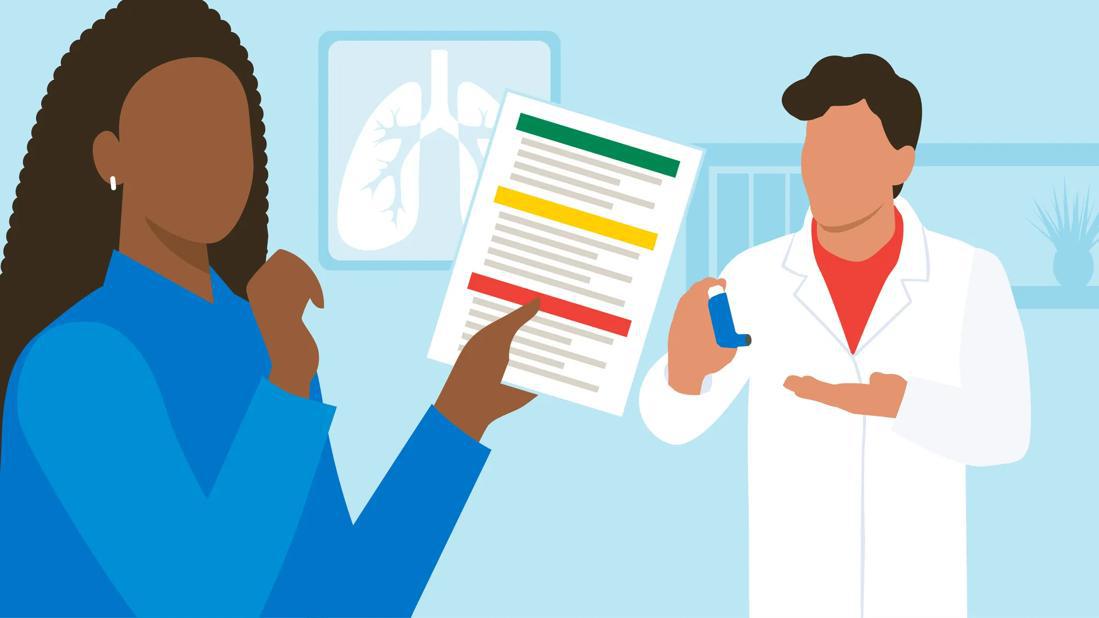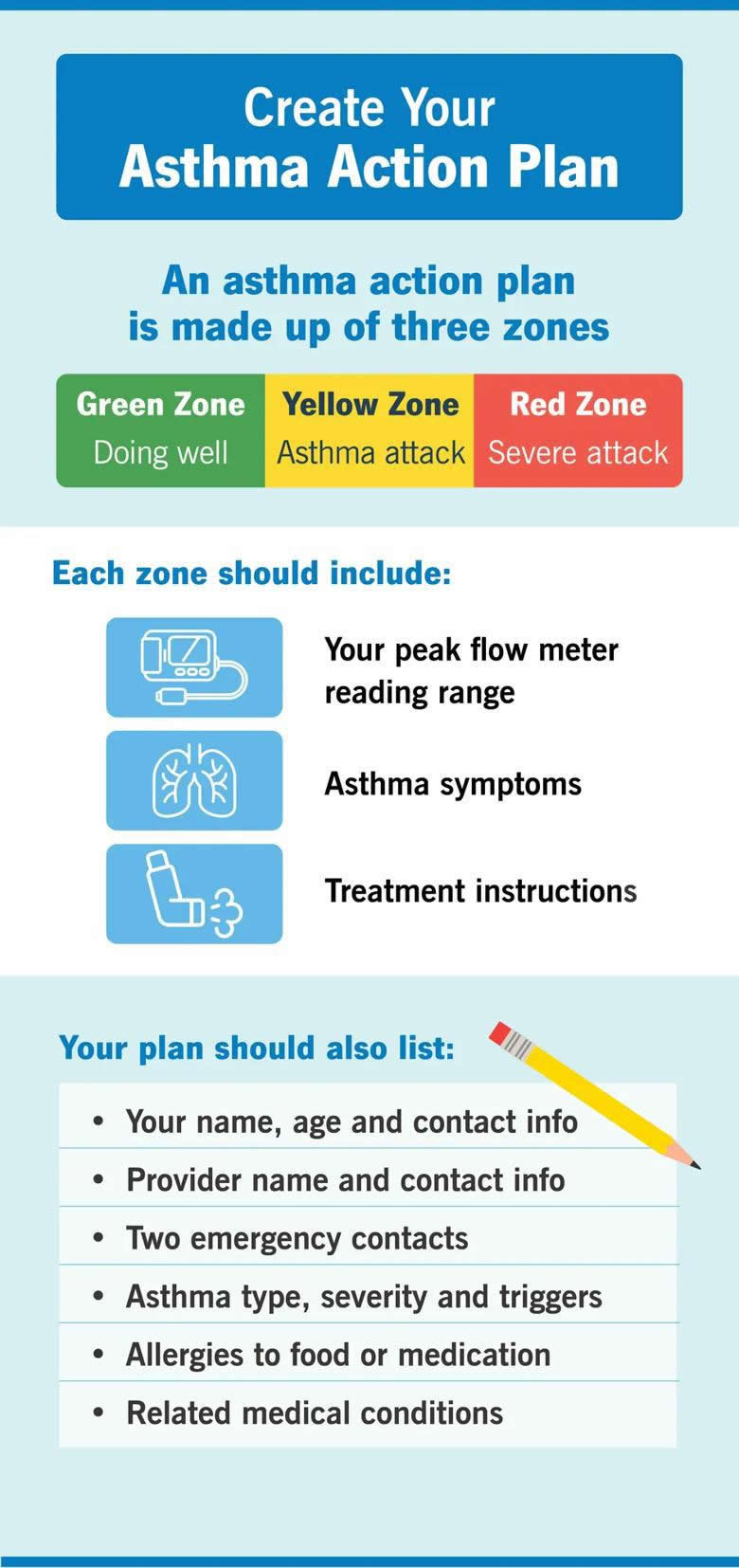Your Guide To Creating an Asthma Action Plan
An asthma action plan is a personalized, step-by-step set of instructions for handling asthma attacks

Asthma attacks can be unpredictable and scary. But planning for them ahead of time can ensure that you get the help you need — fast.
Pulmonologist Rachel Taliercio, DO, explains what an asthma action plan is, why you need one and how to create it.
What is an asthma action plan?
An asthma action plan is a personalized document that spells out the nature of your asthma, the meds you need and the actions to take during an attack. It’s broken down into three stages, so it’s clear what steps to use based on your symptoms. It takes the guesswork out of responding to an asthma attack, which can save time and help you stay calm.
“Having a plan in place isn’t just helpful when you get sick,” Dr. Taliercio explains. “It can also help you manage your asthma day-to-day. It’s equally useful for caregivers, physicians and emergency contacts. And if you’re a parent, it’s a crucial resource for childcare workers and teachers.”
The three zones
An asthma action plan is built with the help of your provider and is broken into three different categories or zones. They’re color-coded to help readers figure out the steps they need to take to best help you.
| Your zone | What it means |
|---|---|
| Green | You’re doing well. |
| Yellow | You’re having an asthma attack. Call your provider. |
| Red | You’re having a major asthma attack. Call both your provider and 911 or emergency services. |
| Your zone | |
| Green | |
| What it means | |
| You’re doing well. | |
| Yellow | |
| What it means | |
| You’re having an asthma attack. Call your provider. | |
| Red | |
| What it means | |
| You’re having a major asthma attack. Call both your provider and 911 or emergency services. |
What’s in an asthma action plan?

Each zone in your asthma action plan will have:
- A list of symptoms:This is how you, or the person reading your plan, will decide how severe your asthma is — and what to do about it.
- Peak flow info:Your peak flow is how fast you can push air out of your lungs when blowing as hard and as fast as you can on a peak flow meter. Knowing your personal best (and your readings in each zone) will help figure out how bad your asthma attack is.
- A list of medications:Your doctor will prescribe specific medicines for each type of symptom you may have and under what circumstances you need to take them.
- Treatment instructions:This includes information about dosing, intervals and how to know when an asthma attack is too dangerous to treat yourself.
Dr. Taliercio says an asthma action plan should also have content that isn’t specific to the three zones, like:
- Your full name, age and contact info:A bad asthma attack can make talking hard. This data is helpful if someone has to call 911 for you.
- Your provider’s contact information: The sooner first responders can access your medical records and speak with your doctor, the better.
- Two emergency contacts:It’s a good idea to have more than one emergency contact, in case one’s unreachable.
- When it was last updated:This helps others know how current your asthma action plan is.
- How severe your asthma typically is:Does your doctor describe your asthma as intermittent or persistent? Is it mild, moderate or severe? If you don’t know, it’s time to find out!
- Your asthma triggers:Everyone has different asthma triggers, like changing seasons, certain foods, dust, exercise or even stress.
- Your immunization history: Dr. Taliercio notes that asthma can signal an upper respiratory infection, so it’s helpful to know whether you’ve been vaccinated against COVID-19, the flu, RSV, whooping cough and pneumonia.
- Severe allergies:It’s important for caregivers to know about drugs, foods and other substances that can make your breathing issues worse.
- Related conditions: COPD, lung cancer, diabetes and coronary artery disease are just a few examples of chronic health issues that impact both your lung function and the treatment you need in an emergency.
Who to share it with
An asthma action plan makes managing your condition easier and gives you peace of mind. But it’s also a useful tool to share with people who care for you. That includes your family, professional caregivers and emergency contacts.
If you’re drafting an asthma action plan for a child, share it with their school. That means their teachers, the school nurse and anyone responsible for their well-being, from carpool parents to coaches. Also, check to see if your child’s school or school district has policies around asthma medications and emergencies.
What if you have an asthma attack when you’re out and about? Dr. Taliercio recommends carrying a copy of the plan (along with a peak flow meter and any meds you need) with you. If you worry about losing the paper, wear a medical alert bracelet with a QR code on it. That way, first responders can access your plan with their phones.
How often you should update it
Expect to update your asthma action plan with your provider during every office visit, in response to changing symptoms.
“An asthma action plan isn’t a one-size-fits-all document,” Dr. Taliercio points out. “It’s personalized to your needs. And those needs may shift. So, the plan’s not set in stone.”
Using your asthma action plan
Having an asthma action plan is great, but you also have to know how to follow it. Here are some tips to help you get comfortable using your plan:
- If you’re having symptoms, match them to the proper zone.
- Check your peak flow reading and see if it aligns with the green, yellow or red zone. If steps one and two give you different results, assume the attack is more severe, to be safe.
- Take the meds your doctor recommends for the zone you’re in. Follow any directions they include about dosing, intervals, and more.
- If you’re in the yellow or red zone, contact either your asthma care provider or 911 or emergency services. Do not try to drive to the ER if you’re struggling to breathe.
“Having an asthma attack can be scary, but there’s power in preparation,” Dr. Taliercio reassures. So, don’t hesitate: Make an appointment to create (or update) your asthma action plan today.